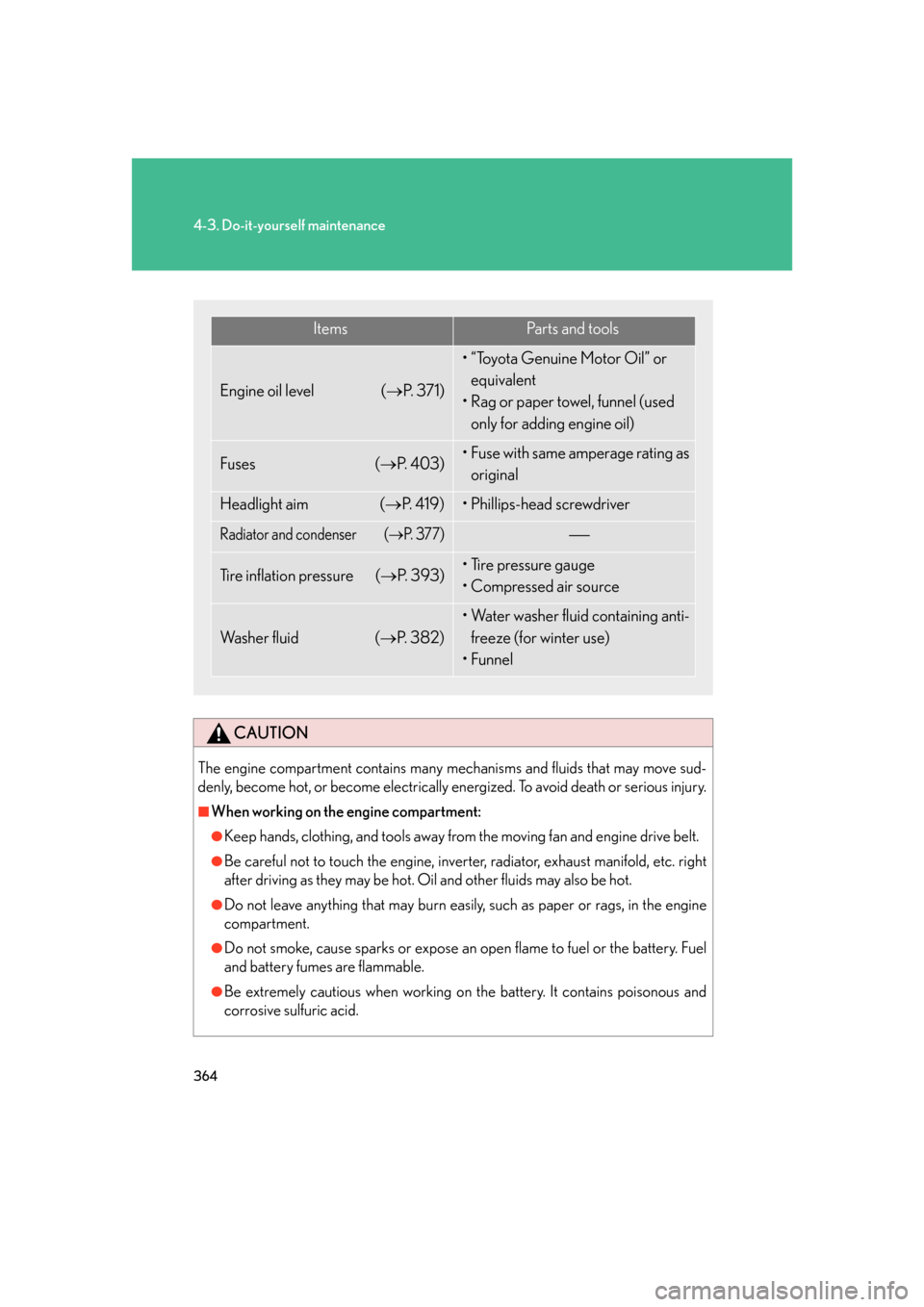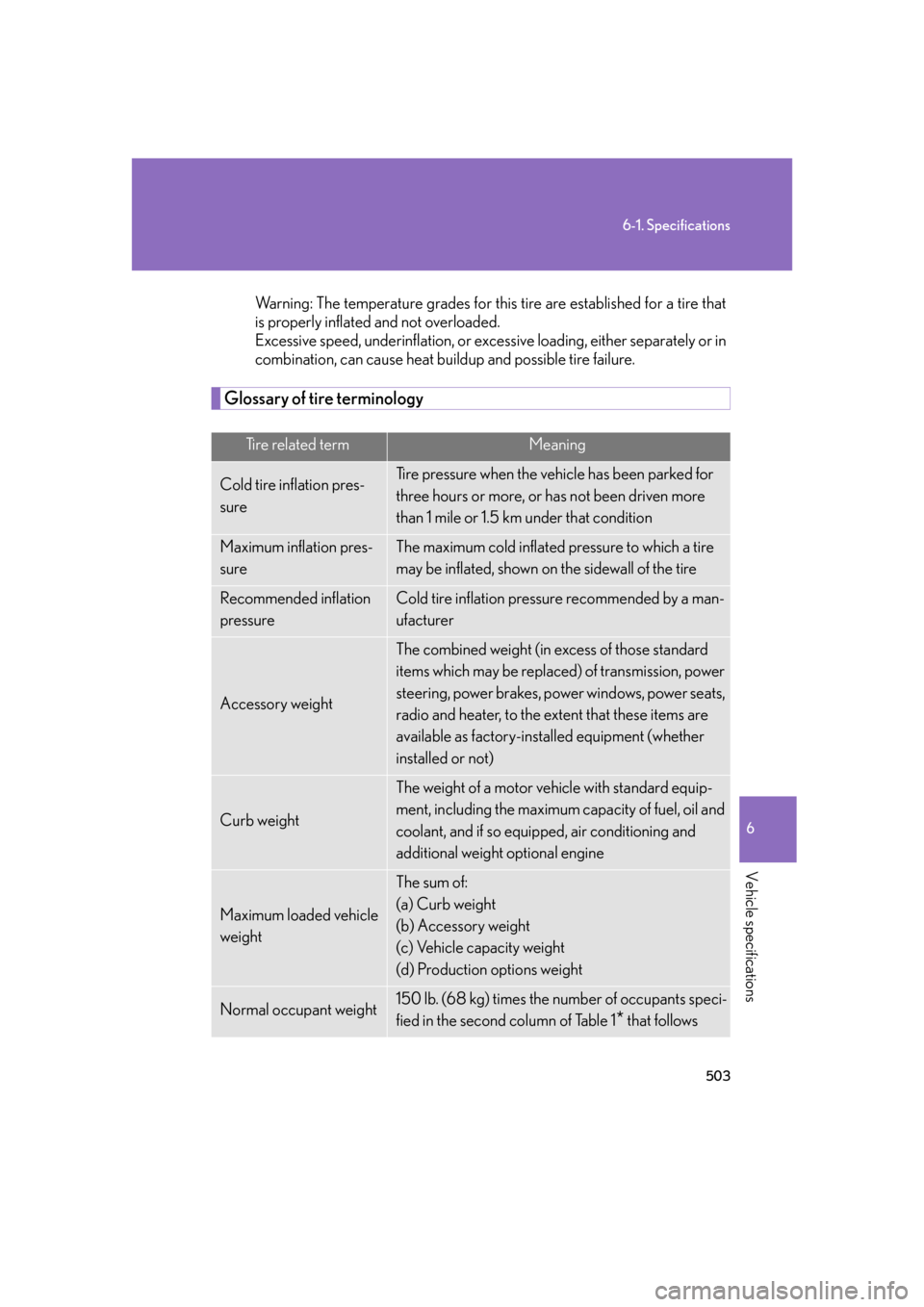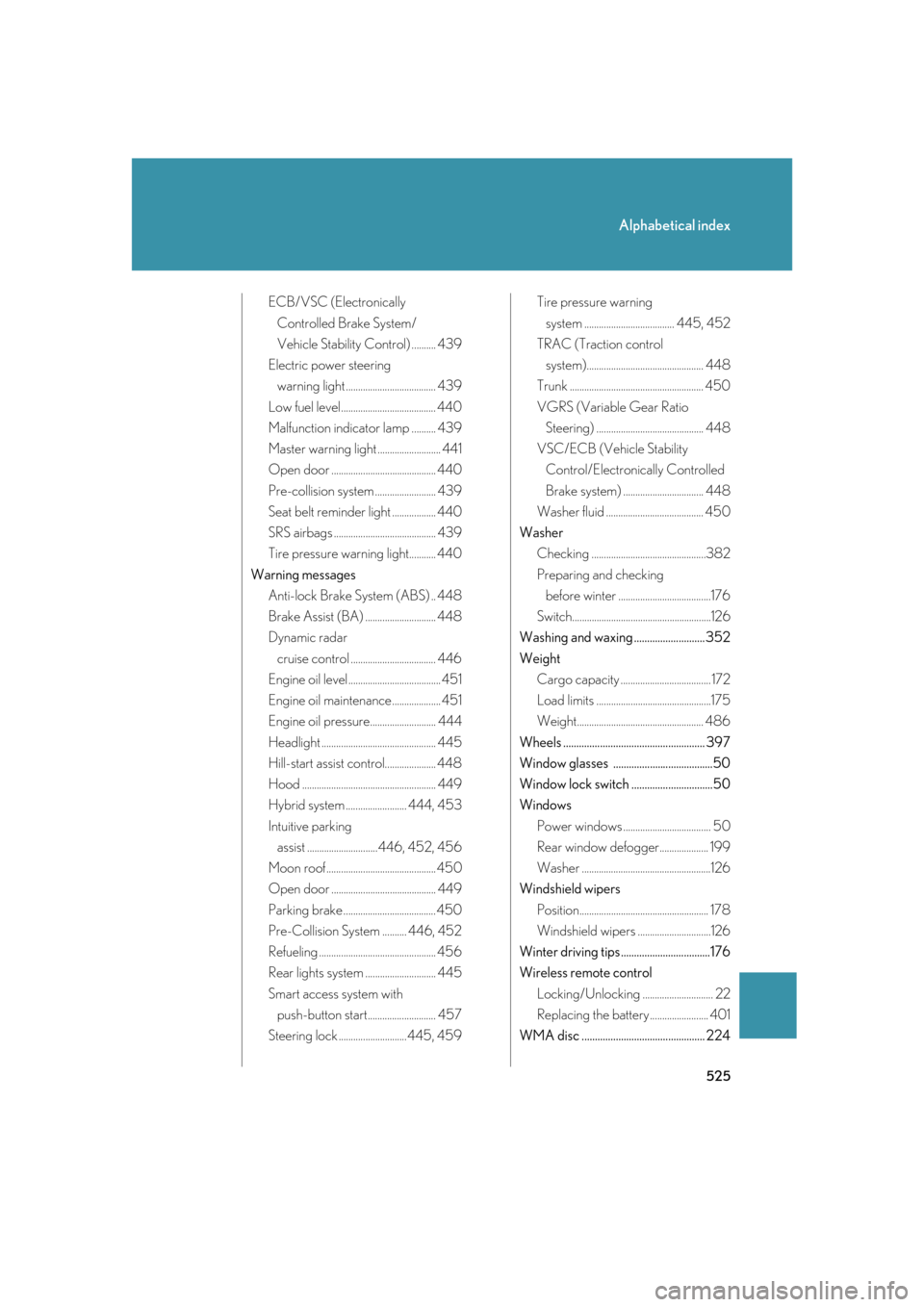fuel pressure Lexus GS450h 2007 Using the audio system / LEXUS 2007 GS450H FROM JULY 2006 PROD. OWNER'S MANUAL (OM30A05U)
[x] Cancel search | Manufacturer: LEXUS, Model Year: 2007, Model line: GS450h, Model: Lexus GS450h 2007Pages: 548, PDF Size: 16.31 MB
Page 7 of 548

vii
Tire
●Rotation
● Replacement
● Inflation pressure
● Information
P. 383
P. 461
P. 493
P. 498
Tail lights P. 122
Side marker light P. 122
Trunk P. 29
Rear window defogger P. 199
Door P. 25
Fuel filler door P. 55
Turn signal light P. 110
: If equipped
Page 77 of 548

57
1-6. Refueling
1
Before driving
■When the fuel filler door opener switch is inoperable
CAUTION
■When refueling the vehicle
Observe the following precautions while refueling the vehicle. Failure to do so, may
result in death or serious injury.
●Touch the vehicle or some other metal surface to discharge any static electricity.
Sparks resulting from discharging static electricity may cause the fuel vapors to
ignite.
●Always hold the grips on the fuel tank cap and turn it slowly to remove it.
A whooshing sound may be heard when the fuel tank cap is loosened. Wait until
the sound cannot be heard before fully re moving the cap. In hot weather, pressur-
ized fuel may spray out the filler neck and cause injury.
●Do not allow anyone that has not discharged static electricity from their bodies to
come close to an open fuel tank.
●Do not inhale vaporized fuel.
Fuel contains substances that are harmful if inhaled.
●Do not smoke while refueling the vehicle.
Doing so may cause the fuel to ignite and cause a fire.
●Do not return to the vehicle or touch an y person or object that is statically
charged.
This may cause static electricity to build up , resulting in a possible ignition hazard.
If the fuel filler door opener switch is inopera-
ble, contact your Lexus dealer to service the
vehicle. If you must refuel your vehicle, you
can open the fuel filler door manually as
shown. The system to lower internal pressure
may not be functioning so you must turn the
cap slowly as the pressure releases. In addi-
tion, fuel may spill out during refueling. Fill the
fuel tank carefully and slowly.
Page 372 of 548

352
4-1. Maintenance and care
Cleaning and protecting the vehicle exterior
■Automatic car washes
●Fold the mirrors back before washing the vehicle.
●Brushes used in automatic car washes may scratch the vehicle surface and
harm your vehicle’s paint.
■High pressure automatic car washes
Do not allow the nozzles of the car wash to come within close proximity of the win-
dows. Before entering an automatic car wash, check that the fuel filler door is
closed.
■Aluminum wheels
Remove any dirt immediately by using a neutral detergent. Do not use hard brushes
or abrasive cleaners. Do not use strong or harsh chemical cleaners. Use the same
mild detergent and wax as used on the paint.
■Bumpers and side moldings
Do not scrub with abrasive cleaners.
Perform the following to protect the vehicle and maintain it in prime condi-
tion.
● Working from top to bottom, liber ally apply water to the vehicle
body, wheel wells and underside of the vehicle to remove any dirt
and dust.
Wash the vehicle body using a sponge or soft cloth, such as a chamois.
● For hard-to-remove marks, use car wash soap and rinse thor-
oughly with water.
● Wipe away any water.
● If water no longer beads on clea n paint, apply wax when the vehi-
cle body is cool.
Page 384 of 548

364
4-3. Do-it-yourself maintenance
CAUTION
The engine compartment contains many mechanisms and fluids that may move sud-
denly, become hot, or become electrically energized. To avoid death or serious injury.
■When working on the engine compartment:
●Keep hands, clothing, and tools away from the moving fan and engine drive belt.
●Be careful not to touch the engine, inverter, radiator, exhaust manifold, etc. right
after driving as they may be hot. Oil and other fluids may also be hot.
●Do not leave anything that may burn easily , such as paper or rags, in the engine
compartment.
●Do not smoke, cause sparks or expose an open flame to fuel or the battery. Fuel
and battery fumes are flammable.
●Be extremely cautious when working on the battery. It contains poisonous and
corrosive sulfuric acid.
ItemsPa r t s a n d t o o l s
Engine oil level ( P. 3 7 1 )
• “Toyota Genuine Motor Oil” or
equivalent
• Rag or paper towel, funnel (used
only for adding engine oil)
Fuses ( P. 4 0 3 )• Fuse with same amperage rating as
original
Headlight aim ( P. 4 1 9 )• Phillips-head screwdriver
Radiator and condenser (P. 377)
Tire inflation pressure ( P. 393)• Tire pressure gauge
• Compressed air source
Wa s h e r f l u i d ( P. 3 8 2 )
• Water washer fluid containing anti-
freeze (for winter use)
•Funnel
Page 415 of 548

395
4-3. Do-it-yourself maintenance
4
Maintenance and care
■Effects of incorrect tire inflation pressure
Driving with incorrect tire inflation pressure may result in the following:
●Reduced fuel efficiency
●Reduced driving comfort and tire life
●Reduced safety
●Damage to the drive train
If a tire needs frequent refilling, have it checked by your Lexus dealer.
■Instructions for checking tire inflation pressure
When checking tire inflation pressure, observe the following:
●Check only when the tires are cold.
If your vehicle has been parked for at least 3 hours and has not been driven for
more than 1 mile or 1.5 km, you will get an accurate cold tire inflation pressure
reading.
●Always use a tire pressure gauge.
The appearance of the tire can be misleadi ng. In addition, tire inflation pressures
that are even just a few pounds off can degrade ride and handling.
●Do not bleed or reduce tire inflation pressure after driving. It is normal for the
tire inflation pressure to be higher after driving.
●Never exceed the vehicle capacity weight.
Passengers and luggage weight should be placed so that the vehicle is bal-
anced.
Page 460 of 548

440
5-2. Steps to take in an emergency
Have the malfunction repaired immediately.After taking the specified steps to correct the suspected problem, check
that the warning light turns off.
Warning lightWarning light/DetailsCorrection procedure
Open door warning light
(warning buzzer)
*2
A door or the trunk is not
fully closed.
Check that all doors and the
trunk are closed.
Low fuel level warning light Remaining fuel
(Approximately 2.6 gal. [10
L, 2.2 Imp.gal.] or less)
Refuel the vehicle.
Driver’s seat belt reminder
light (warning buzzer)
*3
Warns the driver to fasten
his/her seat belt.Fasten the seat belt.
Front passenger’s seat belt
reminder light
(warning buzzer)
*3
Warns the front passenger to
fasten his/her seat belt.
Fasten the seat belt.
Tire pressure warning light
When the light comes on:
Low tire inflation pressure.Adjust the tire inflation pres-
sure.
When the light comes on after
blinking for 1 minute:
Malfunction in the tire pres-
sure warning system.
Have the system checked by
your Lexus dealer.
Page 475 of 548

5
When trouble arises
455
5-2. Steps to take in an emergency
CAUTION
■Maintenance of the tires
Each tire, including the spare (if provided), should be checked monthly when cold
and inflated to the inflation pressure re commended by the vehicle manufacturer on
the vehicle placard or tire inflation pressure label (tire and load information label).
(If your vehicle has tires of a different size than the size indicated on the vehicle
placard or tire inflation pressure label [tire and load information label], you should
determine the proper tire inflation pressure for those tires.)
As an added safety feature, your vehicle has been equipped with a tire pressure
monitoring system (TPMS-tire pressure warning system) that illuminates a low tire
pressure telltale (tire pressure warning light) when one or more of your tires is sig-
nificantly under-inflated. Accordingly, when the low tire pressure telltale (tire pres-
sure warning light) illuminates, you should stop and check your tires as soon as
possible, and inflate them to the proper pressure. Driving on a significantly under-
inflated tire causes the tire to overheat an d can lead to tire failure. Under-inflation
also reduces fuel efficiency and tire tread life, and may affect the vehicle's handling
and stopping ability.
Please note that the TPMS (tire pressure warning system) is not a substitute for
proper tire maintenance, and it is the driver's responsibility to maintain correct tire
pressure, even if under-inflation has not reached the level to trigger illumination of
the TPMS low tire pressure telltale (tire pressure warning light).
Your vehicle has also been equipped with a TPMS (tire pressure warning system)
malfunction indicator to indicate when th e system is not operating properly. The
TPMS (tire pressure warning system) malf unction indicator is combined with the
low tire pressure telltale (tire pressure warning light). When the system detects a
malfunction, the telltale will flash for approximately one minute and then remain
continuously illuminated. This sequence will continue upon subsequent vehicle
start-ups as long as the malfunction exists . When the malfunction indicator is illumi-
nated, the system may not be able to detect or signal low tire pressure as intended.
TPMS (tire pressure warning system) malfunctions may occur for a variety of rea-
sons, including the installation of replacem ent or alternate tires or wheels on the
vehicle that prevent the TPMS (tire pressure warning system) from functioning
properly. Always check the TPMS (tire pressure warning system) malfunction tell-
tale after replacing one or more tires or wheels on your vehicle to ensure that the
replacement or alternate tires and wheels allow the TPMS (tire pressure warning
system) to continue to function properly.
Page 482 of 548

462
5-2. Steps to take in an emergency
■The compact spare tire
●The compact spare tire is identified by the label “TEMPORARY USE ONLY”
on the tire sidewall.
Use the compact spare tire temporarily only in an emergency.
●Make sure to check the tire inflatio n pressure of the compact spare tire.
( P. 4 9 3 )
■Tr e a d l i f e
The compact spare tire can be used many times, if necessary. It has tread life of up
to 3000 miles (4800 km) depending on road conditions and your driving habits.
When treadwear indicato rs appear on the tire, replace the tire. ( P. 383)
■When using the compact spare tire
As the spare tire is not equipped with the tire pressure warning valve and transmit-
ter, low inflation pressure of the spare tire will not be warned. Also, if you replace the
compact spare tire after the tire pressure warning light comes on, the light remains
on.
■ Compact spare tire
The compact tire saves space in your luggage compartment, and its
lighter weight helps to enhance fuel economy and permits easier
installation in case of a flat tire.
The compact spare tire is
designed for temporary emer-
gency use only.
Page 523 of 548

503
6-1. Specifications
6
Vehicle specifications
Warning: The temperature grades for this tire are established for a tire that
is properly inflated and not overloaded.
Excessive speed, underinflation, or excess ive loading, either separately or in
combination, can cause heat build up and possible tire failure.
Glossary of tire terminology
Tire related termMeaning
Cold tire inflation pres-
sureTire pressure when the vehicle has been parked for
three hours or more, or has not been driven more
than 1 mile or 1.5 km under that condition
Maximum inflation pres-
sureThe maximum cold inflated pressure to which a tire
may be inflated, shown on the sidewall of the tire
Recommended inflation
pressureCold tire inflation pressure recommended by a man-
ufacturer
Accessory weight
The combined weight (in excess of those standard
items which may be replaced) of transmission, power
steering, power brakes, power windows, power seats,
radio and heater, to the extent that these items are
available as factory-installed equipment (whether
installed or not)
Curb weight
The weight of a motor vehicle with standard equip-
ment, including the maximum capacity of fuel, oil and
coolant, and if so equipped, air conditioning and
additional weight optional engine
Maximum loaded vehicle
weight
The sum of:
(a) Curb weight
(b) Accessory weight
(c) Vehicle capacity weight
(d) Production options weight
Normal occupant weight150 lb. (68 kg) times the number of occupants speci-
fied in the second column of Table 1
* that follows
Page 545 of 548

525
Alphabetical index
ECB/VSC (Electronically
Controlled Brake System/
Vehicle Stability Control) .......... 439
Electric power steering warning light ..................................... 439
Low fuel level....................................... 440
Malfunction indicator lamp .......... 439
Master warning light .......................... 441
Open door ........................................... 440
Pre-collision system ......................... 439
Seat belt reminder light .................. 440
SRS airbags .......................................... 439
Tire pressure warning light........... 440
Warning messages Anti-lock Brake System (ABS) .. 448
Brake Assist (BA) ............................. 448
Dynamic radar cruise control ................................... 446
Engine oil level ...................................... 451
Engine oil maintenance.................... 451
Engine oil pressure........................... 444
Headlight ............................................... 445
Hill-start assist control..................... 448
Hood ....................................................... 449
Hybrid system ......................... 444, 453
Intuitive parking
assist .............................446, 452, 456
Moon roof ............................................. 450
Open door ........................................... 449
Parking brake ...................................... 450
Pre-Collision System .......... 446, 452
Refueling ................................................ 456
Rear lights system ............................. 445
Smart access system with
push-button start............................ 457
Steering lock ............................445, 459 Tire pressure warning
system ..................................... 445, 452
TRAC (Traction control
system)................................................ 448
Trunk ....................................................... 450
VGRS (Variable Gear Ratio
Steering) ............................................ 448
VSC/ECB (Vehicle Stability
Control/Electronically Controlled
Brake system) ................................. 448
Washer fluid ........................................ 450
Washer Checking ...............................................382
Preparing and checking
before winter ......................................176
Switch.........................................................126
Washing and waxing ........................... 352
Weight Cargo capacity ..................................... 172
Load limits ...............................................175
Weight.................................................... 486
Wheels ...................................................... 397
Window glasses ......................................50
Window lock switch ...............................50
Windows Power windows .................................... 50
Rear window defogger.................... 199
Washer .....................................................126
Windshield wipers Position..................................................... 178
Windshield wipers ..............................126
Winter driving tips ..................................176
Wireless remote control Locking/Unlocking ............................. 22
Replacing the battery........................ 401
WMA disc ............................................... 224